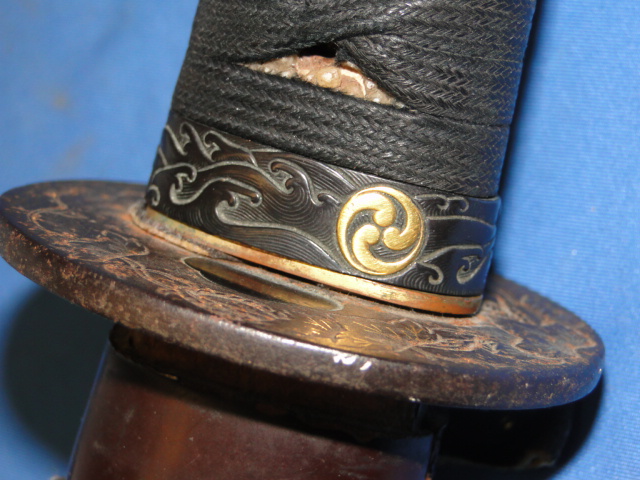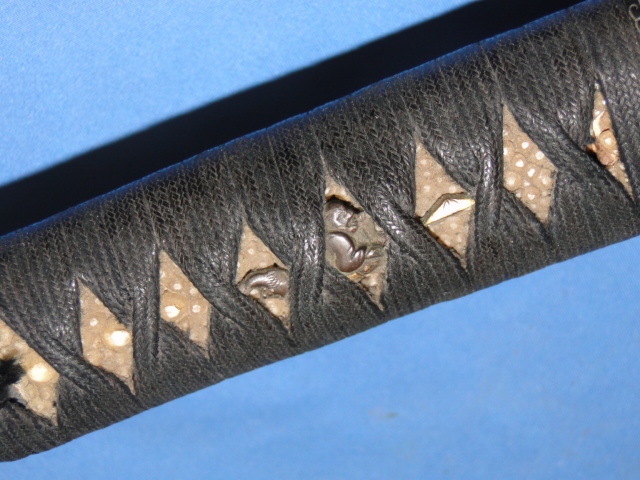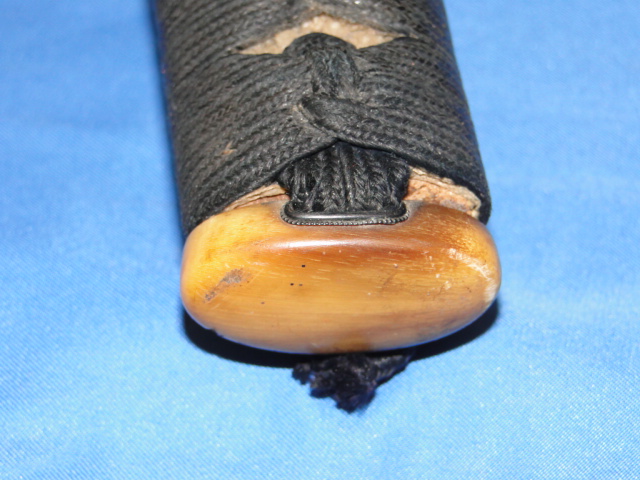SAMURAI SWORD 45 - 1800's WAKISASHI
This is a Japanese Samurai Wakisashi sword. Dating back to the late 1700's or early 1800's. This is an interesting
piece in the sense that the scabbard is covered with a Japanese Navy leather cover, but the rest of the fittings
are not military. Also, the handle has a leather strap that matches the cover and has a snap, but the cover
itself does not have the female component of the snap. Therefore the sword cannot be secured to the scabbard.


The metal cap at the base of the handle is beautifully adorned with a family crest and a pattern of ocean waves.
The family crest could mean two different things. One is that the soldier claimed lineage to a Samurai class. The
other is that the officer had enough money to pay and attach it as an ornament.
Usually this piece would match the Tsuba and pommel (Kashira). However, in this example none of them match which
indicate they have been replaced. Click here to see an example of a
matching set.

|
This page is a recognition and identification guide for Samurai swords.
Multiple detailed photos of a specific sample are provided. Descriptions point
out clearly defined points that should be noted.
One of the most commonly asked questions is "How much is my Samurai Sword worth?".
A price guide is included here to address this question. The value of the swords is
reviewed over a period of several years. A trend can be observed. The present worth
of the edge weapons in the collector's market is illustrated.
This service is provided free of charge to the visitor/enthusiast courtesy of
MilitaryItems.com,
a company dedicated to the preservation of military history and to providing quality
military antiques and collectibles to museums, institutions and the general public.
|
|

The scabbard is made of wood and has a traditional finish applied to it. A loop is attached near the throat
section. This was basically a belt loop to allow the sword to be carried.
A closer view at the heavy duty cover is seen here. the leather is fairly thick and has a chamois-like finish.
The side is stiched with heavy duty thread.



The Menuki are clearly visible on both sides of the handle. The mottiff is that of fishermen. The Menuki do not
match. In most cases they do but not always. Very nice workmanship. They date back to around mid 1800's.

The Habaki was executed very nicely. Instead of being a flat version this one has two lines cutting across. One line
is much thicker than the other. A very nice visual treat. The material of construction appears to be copper.
Part of the blade is visible here. There is no damage to the edge. No remains of the hammon are visible. The
blade appears to have the original polish.

The sword has a short tang. No signatures or markings are found on either side. A single hole is placed near the
base. The end is in a pointed shape. The sword is the original length that was created. It has not been
shortened.



The Kashira is a replacement that was made of bone. very nice workmanship is displayed in making it fit. the
sides have a metal insert.



This Samurai Sword may be currently reproduced.
It is becoming more difficult to be able to tell the fake ones from the real ones because
the quality of the reproductions is improving. The collector must become familiarized with
the construction style and materials employed in the manufacturing of this item.
Attention to the details is critical in order to be able to determine the authenticity of
the collectible.
If you have an interest is seeing other Japanese Samurai swords, you can do so by going to our
Japanese Samurai Swords Price Guide
identification guide. Where we cover Samurai swords from all periods.
| 




